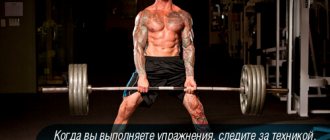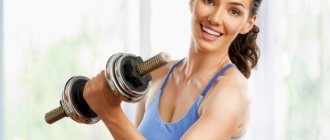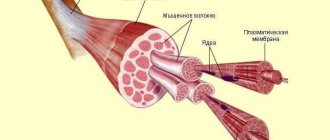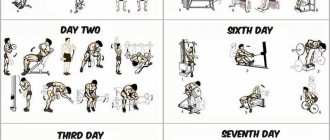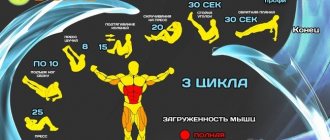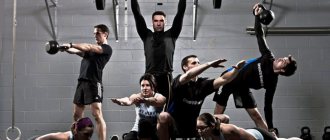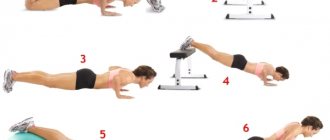To be able to move freely without discomfort or pain is a great reward. You don’t think about it until one day your lower back hurts.
According to statistics, back pain is the second cause of absenteeism after the most common illness such as the common cold. Over 70% of residents of developed countries complain about its occurrence.
The cause of discomfort in most cases is underdeveloped back muscles. They cannot withstand the load because the person moves little and mostly just sits.
To avoid such problems, you need to strengthen your back - this is understandable and known to everyone. If you come to any gym, the instructors will definitely offer a training plan that will help develop the required muscle group. However, not all so simple.
A little anatomy
There are two types of muscles in the human body: dynamic and postural.
The work of the first group of muscles, which are located close to the surface of the body, is simple, quick movements that a person can control by willpower. For example, it is easy for us to raise our arm or bend our leg. These muscles have few blood capillaries and quickly fatigue due to the accumulation of lactic acid.
Postural muscles, or as they are also called, tonic muscles, are located deep, next to the spine. They are responsible for the vertical position of the body during movement, as well as posture and posture. They work against gravity. We cannot regulate the work of these muscles with our consciousness, since the subcortical structures of the brain are responsible for their functions.
These are the smallest muscles, but very strong, since they can hold tension, unlike the dynamic group, for a long time. Lactic acid accumulates slowly, since they are abundantly supplied with blood vessels.
What are the benefits of training?
Functional training is exercises that are aimed at improving the physical condition of stabilizer muscles. They are located deep in the human muscular system and perform a very important function: they hold the body in various positions. These workouts will help develop a sense of balance, increase flexibility, give confidence in movement and improve control over them. This type of physical activity develops dexterity and grace in a person, increases the endurance of the body and body, and adds strength. Some trainers say that functional exercises can even have therapeutic effects. For example, with the help of such activities you can get rid of scoliosis, prevent the development of dangerous osteochondrosis, and cure headaches.
To maintain a healthy spine, these small muscles need to be trained. Without stability, even the strongest person cannot effectively project power into the environment. Flexibility is a very important aspect of any exercise program, but it is often overlooked. Lack of flexibility in the right places seems to be the cause of many problems. Body movements become difficult when flexibility and posture are distorted. When a muscle is tight, it limits the muscle's ability to contract properly, causing ineffective movements and the risk of injury.
Spinal curvature problems
Modern life provides little opportunity to move. Experiencing static tension, dynamic muscles become weak, and postural muscles become shortened due to increased tone.
An imbalance between these muscles leads to curvature of the spine and disruption of the natural curves of the body. Therefore, not only the appearance suffers, but also the functioning of the musculoskeletal system itself. Accordingly, painful sensations arise. In addition, problems associated with the spine lead to pathologies of internal organs.
Dynamic muscles are quite easy to work, but postural ones are much more difficult. The problem is that a person does not feel or control their work, therefore, to work these muscles, a training system is required, which includes special techniques and exercises.
Benefits of High Intensity Interval Training
- Save time. High-intensity interval training can save you a lot of time. One 20-minute interval workout is equivalent to an hour of low-intensity activity in terms of energy expenditure.
- Increased metabolic rate. Interval training gives the body a stimulus to produce hormones that speed up metabolism. After a workout, your body speeds up your metabolism to repair your muscles.
- Intense fat burning. After training, the body uses subcutaneous fat, which serves as energy for muscle recovery.
- Increased muscle mass. Research shows that HIIT increases muscle mass in beginners, but the gains are only noticeable in the short term. Only strength training gives permanent muscle growth.
Yoga as a basis
Postural training as a trend in fitness has emerged recently. They are based on the principles of yoga. Traditional asanas are aimed at stabilizing and strengthening the muscles of the entire body, with special attention paid to the spine.
The founder of Precise Alignment Yoga, Hert van Leeuwen, went even further. His training system involves relaxing dynamic muscles, as a result of which postural ones are activated. However, a gym training program requires special equipment and the assistance of a trained instructor.
Interval training example
Let's look at interval training using an exercise bike as an example.
| Interval | Time | Load level |
| Warm-up | 5 minutes | Calm pace. Pulse - 50-60% of maximum. |
| Acceleration | 20 seconds | Pulse - 80-90% of max. |
| Recovery | 60 seconds | Pulse - 60% of max. |
| Acceleration | 20 seconds | Pulse - 80-90% of max. |
| Recovery | 60 seconds | Pulse - 60% of max. |
| Acceleration | 20 seconds | Pulse - 80-90% of max. |
| Recovery | 60 seconds | Pulse - 60% of max. |
| Hitch | 5 minutes | Calm pace. Pulse - 50-60% of maximum. |
The duration of this workout is 15 minutes. It's perfect for beginners. First, a warm-up is performed, then three acceleration intervals, which alternate with recovery. After training, a cool-down is performed to gradually bring the body out of its excited state.
Interval training can be done anywhere and without special equipment. For example: running, squats, jumping.
Plank pose
If it is not possible to visit fitness clubs that have similar programs, but you still have a desire to train, we suggest mastering one of the basic yoga exercises.
Training for beginners can consist of one asana and its variations, since the plank pose is a universal exercise. It involves the main muscle groups, including tonic, that is, postural. It can be performed both statically and dynamically.
You need a little free space and a gymnastic or special yoga mat. So:
- Get down on your knees, palms resting on the floor and shoulder-width apart, wrist and elbow joints are located in the same line.
- From the starting position, lift your knees off the floor and take a position in which you lean on your palms and toes, and stay in it for as long as possible.
- The plank on straight arms requires tension in the abdominal muscles in order to avoid arching in the lower back and the muscles of the buttocks in order to prevent sagging towards the floor. When done correctly, the body should look like one straight line.
- For the first time, hold on for 10 seconds, then try to increase the load, at which the duration will be several minutes.
- For a more difficult version of the plank, lower yourself onto your forearms, alternately bending your arms, then return to the starting position. Make sure your elbows remain under your shoulder joints and your forearm and upper arm form a 90-degree angle.
- If it becomes difficult to hold the pose, then for a short rest you can lower your legs to your knees and your hands to your forearms; this is especially true when training is provided for girls. At the same time, the buttocks shift forward, but the abdominal muscles do not relax. From this position, we again enter the plank on outstretched arms or on the forearms.
The training program may also include a dynamic version of the exercise. It works as follows. Taking a plank pose, we alternately pull the knee towards the opposite elbow. We do this at a fast pace, alternating knees. At the same time, do not forget that the body is one straight line, the stomach and buttocks are drawn in and tense as much as possible.
The plank allows you to strengthen the muscles of the abs, buttocks, back and arms. The entire body is involved. Once you have mastered it, you can proceed directly to the main training.
Postural training consists of effective, fairly simple exercises. If you repeat them in a certain sequence, you develop not only strength, but also endurance.
Functional exercises for beginners
At the initial stage, beginners should not strain their muscles excessively. When performing exercises, use your own body weight, learn to perform them correctly. Over time, when you fully master the technique, you can use various weights when performing exercises, and start visiting the gym.
The main advantages of functional training
To create the necessary muscular strength, joint integrity, balance, and flexibility in all planes of movement, it is important to exercise the body functionally. It is critical to include multi-dimensional and multi-dimensional exercises as this recruits the body's stabilizers to synergistically facilitate movement. This ensures that the nervous system is working correctly and that all parts of the body are used appropriately, with the correct muscles firing at the right time. This doesn't mean you shouldn't include some so-called non-functional exercises, including machine or old-school exercises, which can be healthy, safe and fun when used correctly.
- Pushups. Among various functional exercises, this is the one that takes the leading place. During the push-up process, a person develops his arms and shoulders, engages his abs, and develops his pectoral muscles. Only proper execution of this exercise will strengthen the above muscles. Under no circumstances should you lower your stomach or raise your buttocks. If it is immediately difficult to do push-ups from the floor, then you can start with push-ups from the sofa or wall. Over time, you will be able to perform this exercise with your legs over an object or sports equipment.
- An exercise such as “squats” plays a significant role. Such exercises allow you to develop your legs as efficiently as possible. During this exercise, the gluteal muscles, quadriceps, and thigh muscles are activated and strengthened. At first glance, it seems that squats do not cause difficulties. There is no need to flatter yourself. If this exercise is performed incorrectly, there is a high probability of damaging the knee joint. After you master the technique of performing this exercise and your muscles become stronger, you can use additional load (dumbbells, kettlebell, barbell, etc.).
- Lunges, like the previous exercise, allow you to develop your leg muscles. This exercise is very simple to perform. We are in a standing position. Both hands must be placed on the belt. From this position, we alternately make lunges with our right foot and then with our left. At your own discretion, you can take simple steps forward, or you can linger in this position after the lunge.
- Rotations. This exercise is designed to develop and strengthen the muscles of the lumbar region, as well as the oblique muscles in the abdomen. Some people simply twist their torso in different directions. Over time, when the body gets stronger, you can use additional force when rotating, which can be an elastic fitness band, which we attach to any hook, or simply to a door handle.
- Pull-ups. To perform this exercise you will need a crossbar. Among all the functional exercises in which we use our own weight, this is considered the most difficult, allowing us to develop and strengthen the back muscles. When doing pull-ups with a reverse grip, the biceps develop. It is quite difficult for beginners to immediately perform pull-ups. To make it a little easier, you can ask a friend for help or use a special exercise machine in the gym.
Thanks to simple functional training, everyone can strengthen the muscles of their body and make it more attractive.
What is functional training
To create a functional program, the trainer must set realistic goals and understand the client's weaknesses, daily routines, and limitations.
A trainer should be able to identify postural distortions and incorporate exercises that correct them, but more importantly, they should educate the client on what movements or activities to avoid or modify throughout their day. It's not what you do; it's how you do it. The ability to identify postural distortion depends on the trainer's understanding of muscle anatomy, motor patterns, and function. The CandyGym gym invites everyone who wants to get in great physical shape, as well as those who dream of playing sports professionally. You have the opportunity to independently choose a personal instructor with whom you will be comfortable studying. We have in our arsenal only the most modern equipment, which allows us to work on the latest programs.
The trainer must also determine when the muscles are more active and fire out of sequence, or not fire at all. Synergistic dominance is common in most postural dysfunctions. In general, if the agonist is tight, the antagonist is weak, creating increased stress on the joint. This can lead to repetitive stress, which will ultimately lead to accelerated joint degeneration.
Basic stability, flexibility and balance are key factors when designing a functional workout. It is important to maintain posture by being able to move all joints through a full range of motion. Training with free weights and a stimulating environment promotes balance and stability, which is essential if you expect to see benefits outside of the gym. Keep in mind that it is more important to be able to control your own body weight and focus on form, balance and core endurance than to move heavy loads.
Functional training is a very popular term nowadays, which is widely used in such active fields as sports and fitness. This often involves work that requires constant movement. By doing this type of exercise, a person trains all the muscles of the body that are involved in everyday life. Exercises in gyms, so boring for athletes and adherents of a healthy lifestyle, are mainly aimed at loading certain muscle groups. Functional training is about working muscles throughout the body. Movements during exercises can vary in difficulty level, depending on the purpose of the particular activity. People who use have the ability to learn new skills faster than others.
Weight loss training
The functional core routine consists of dynamic movements, isometric exercises and center of gravity problems. To fully train the core, you must also include dynamic stabilization, isometric and proprioceptive movements not only for the midsection, but for the entire trunk. Medicine balls, balance boards, foam rollers and physiopods are excellent tools for core activity preparation and should be integrated into every program. It is a fact that physio ball training is superior to traditional floor exercises.
Warm-up
Training for beginners as well as advanced athletes should begin with a short warm-up. It consists of yoga asanas and serves to prepare muscles and joints for serious exercise.
So, let's begin:
- Get into plank pose.
- From there, smoothly move into the “downward-facing dog” asana. To do this, pull away from your hands and straighten your legs, while your heels tend to the floor and your head hangs freely. Stay in this position for 16 counts.
- After this, lift your heels off the floor one by one, stretching your feet, and perform ten repetitions on each leg.
- Lunge deeply with your right leg so that your foot is level with the outside of your hand. Hold for a few counts and straighten your right leg to stretch the ligaments under your knee.
- Lower yourself into a deep lunge again, try to bring your right forearm closer to the floor, perform two more repetitions.
- As you exhale, turn your body towards your right bent leg and extend your arm upward, while keeping your left hand firmly pressed to the floor. Direct your gaze to your fingers and hold in this position for 16 counts.
- Go to the “one warrior pose” asana; to do this, straighten your body vertically, raise your arms in parallel. In this case, the right leg remains in a lunge, the thigh and knee make an angle of 90 degrees, the knee is located exactly above the heel. Turn your gaze to your hands and lean back, do not bend at the lower back, but open your chest.
- After 16 counts, return to plank pose and repeat the warm-up for your left leg.
Interval Training Recommendations
Beginners often make mistakes when doing interval training. This section contains basic tips that will help you start training correctly.
- Keep a training diary. It will help you correctly calculate the load. Write down how long the workout took, how many intervals you did, and how you felt. All this data will help control overtraining and gradually increase the load.
- Increase the load gradually. It shouldn’t be that you worked out for 20 minutes in the first workout, and all 60 in the second.
- Don't overdo it with the amount of training. The ideal number of classes per week is 2-3. Don't do interval training every day as your body won't recover.
- Don't neglect warming up. Before training, do a 3-5 minute warm-up at a calm pace to smoothly get your body into working condition and prepare for high-intensity exercise.
Squats
The work includes hips, legs, back and arms.
- To begin, place your feet shoulder-width apart and spread your arms out to the sides with your palms facing away from you. The back should be straight.
- As you exhale, perform a squat; to do this, bend your knees, while your thigh should be parallel to the floor. You should not squat deeper so as not to unnecessarily strain the knee joint. Keep your arms apart, your back straight, and do not lean too far forward. Make sure that your knee does not extend far beyond your foot; ideally, it is above the heel.
- Hold for 4 counts and rise up.
What is the basis of LPF training?
The basis of LPF is hypopressive gymnastics (hypopressive from the Greek hypo - decrease, pressive - pressure) - exercises for the abdominal muscles and pelvic floor without negative effects on the center of the body. When performed correctly, the abdominal and pelvic floor muscles reflexively contract under the suction effect of the diaphragm.
The LPF training system also combines myofascial stretching and neurodynamic exercises. Myofascial stretching is stretching of human connective tissue (that is, the fascia itself), intended primarily to relieve muscle imbalance and tension. Neurodynamic exercises work with the peripheral nervous system, allowing you to reduce or completely eliminate a lot of pain at the level of the cervical spine, solving the problem of pinched sciatic nerve, carpal tunnel syndrome and other neuralgic diseases.
To put it simply, Low Pressure Fitness is a set of postural (from the English posture - posture) and breathing exercises that improve the aesthetics and quality of life of a person.
“LPF exercises are aimed simultaneously at all human systems - musculoskeletal, respiratory, reproductive, respiratory, nervous. And all this in one workout, which lasts about 20 minutes!
– says Vadim Mishin, LPF master trainer and representative of Low Pressure Fitness in Russia.
— The main difference from other exercises we are used to: relaxation of the main respiratory muscle - the diaphragm.
A lot of work happens with the center of the body - the diaphragm, it relaxes. Relaxing the diaphragm has an immediate effect of lifting the internal organs, activating venous drainage and improving blood circulation .”
Side plank and push-ups
Postural training allows you to activate the work of the lateral muscles of the torso, abs and arms.
- Take a plank pose with your arms extended.
- As you exhale, lift your right arm off the floor and lift it, while the body twists and turns to the right, the hand is directed away from you. The sides of the feet are pressed to the floor.
- Pull your hand up, palm away from you, look at your fingers.
- Return to the plank position and, as you exhale, perform a push-up, with your elbows pointing back. It is important to first turn your pelvis parallel to the floor, and then lower your hand.
- After the push-up, return to the “plank” position and again extend your arm up, twisting your body.
- Workouts for girls may include a simpler version of the side plank, to do this, lower one knee to the floor. Also perform push-ups from your knees.
- Repeat the exercise with your right hand.
Functional exercises - the path to a healthy and beautiful body
Imitating everyday movements is what functional training is all about. Training programs can be varied and use different equipment. An athlete will need not only ordinary exercise equipment, but also shock absorbers, balls, and traction objects. Thus, during training, the muscles move in the most physiological way that suits them. This leads to the fact that strong tension in the joints disappears, the load on the spine decreases, and the likelihood of injury is reduced to almost zero. Since functional exercises can be very diverse, creating an individual one will not be difficult. Functional training is the best way for all those who strive to achieve a beautiful, healthy and toned body, without overloading or overstraining their body and muscular system.
Jump - slide
Postural training is designed in such a way that, along with the work of physical large muscles, very small ones are also included. The following exercise has been developed for this purpose:
- Place your feet shoulder-width apart and bend your knees slightly.
- Jump up and, after landing, take a wide sliding step to the side with your right foot. Place your left leg next to you; your legs remain in a bent position during the exercise.
- Jump again and take a sliding step, now with your left foot to the side.
- Jump again.
Warm-up - stage one
Before starting the main exercises, you need to warm up. First of all, you need to perform jumps: on the spot, back and forth, from foot to foot, from side to side. Each such approach should contain twenty jumps. This exercise will help warm up the muscles of the ankle joints and give the person the tone and mood that subsequent training requires. Functional training also consists of twenty push-ups, ten of which must be performed with a wide arm position. Performing this exercise increases the load on the pectoral muscles, triceps and deltoid muscles. During this exercise, all other human muscles will receive a static load, and the shoulder and elbow joints will warm up.
Without flexibility, body movement becomes limited and good results are difficult to achieve. This article explains the key components of a functional program and its benefits. Traditional weight lifting is a thing of the past and has been shown to provide limited results compared to a functional program. The only way to improve the movement is to imitate the movement in the gym until it becomes autonomous in everyday life. Before starting any exercise program, you should always consult a doctor as well as a qualified fitness professional.
Direct training
The workout program at the gym and at home consists of three approaches, each of which contains five repetitions of each exercise.
So, let's begin:
- Do five squats with your arms spread to the side, increasing the amplitude each time, but your thigh should not fall below parallel with the floor.
- Perform side plank and push-up pose. Repeat the exercise five times for your left and right hands.
- Now you need to perform the “jump-slide” 5 times.
Repeat the complex two more times. The total training time, that is, warm-up and main part, is about 10 minutes.
Answers to popular questions about interval training
- Is interval training effective for losing weight? High-intensity interval training burns 25-30% more fat than low-intensity training.
- How many times a week can you do high-intensity interval training?
Do HIIT no more than 3 times a week, as muscles need about 24 hours to recover.Also, for example, if you had a leg workout in the gym, then you shouldn’t do high-intensity interval training the next day. This time is not enough for muscles to recover.
- How to combine interval and strength training?
Exercise on different days. Ideal: 3 strength and 2 interval training sessions per week. - Which is better - high-intensity interval training or low-intensity training?
There is practically no difference. The only significant difference is time . 20 minutes of interval training is equivalent to 60 minutes of low-intensity activity. At the same time, you will burn the same amount of subcutaneous fat.
Relaxation
Your training plan must include a cool-down. It allows muscles, joints and ligaments to recover after exercise, and also reduces heart rate. The cool-down includes the following exercises:
- Lie on your back, spread your arms to the side, palms down, bend your knees. As you exhale, lower your knees to the left and touch them to the floor, while turning your head to the right. Hold this position for eight counts. Do the same on the other side. Repeat the exercise twice.
What is High Intensity Interval Training?
Visualization of interval training
High-intensity interval training (HIIT) is an alternation of high-intensity (anaerobic) and low-intensity (aerobic) exercise.
For example: running for 20 seconds at maximum speed and 60 seconds at a calm pace. These intervals alternate a certain number of times (depending on the athlete’s level of training).
Maximum effort is performed in the pulse range of 80-95% of the maximum heart rate. Recovery period - 50-60% of max. Heart rate.
For example, you are 20 years old. The pulse zone for maximum load is 172-190 beats per minute, and for the recovery period - 130-156 beats/m.
We calculated this using a special heart rate calculator.
Calculate your heart rate zone
The duration of the workout and each interval depends on the athlete’s training experience. A typical interval workout takes 30 minutes.
Professional athletes use a heart rate monitor in their training to work more accurately in pulse zones, but amateurs can do without it. Start from your feelings and after a few trainings you will understand how to distribute forces.
What are the results of regular LPF training?
Those who exercise note a feeling of a straightened back, a decrease in waist size, and an improvement in their emotional state. Breathing and sexual function improve, back pain and swelling of the legs go away. Muscle tension is relieved and posture improves. Relaxing the diaphragm has an immediate effect of lifting the internal organs, activating venous outflow and improving blood circulation. The result of systematic training can be a reduction in stress urinary incontinence and the lifting of the pelvic organs into place.
Also, classes using the Low Pressure Fitness system are a means of preventing all types of hernias.
“The center of the body must be able to properly distribute pressure inside. The center of the body refers to such anatomical structures as the diaphragm, pelvic floor, abdominal wall, and spine. If the pressure inside is not distributed correctly, then there is a risk of a hernia, for example, in fitness or sports, when lifting weights, jumping, running. LPF exercises – prevention of these phenomena as well
“Explains Vadim Mishin.
Does LPF have a healing effect?
LPF is not only prevention, but also therapy. “ A person can come to classes to prevent problems with the spine. Or in order to better feel postural comfort, that is, developing the habit of keeping your back straight at the level of a reflex - the comfort of a straight posture.
- says the coach.
“ But we can select exercises based on your medical history.
For example, for women after childbirth, for the purpose of recovery, we will give more exercises for the abdominal wall so that the stomach does not protrude. If you have problems with diastasis - separation of the abdominal muscles - we will also select exercises. But all exercises are used in combination, that is, many problems are solved at once - posture is corrected, muscle tension is relieved, and sexual function is improved by improving blood circulation in the pelvis. That is, even if a person comes with a specific problem, at the “exit” he will receive a lot as a bonus .”

